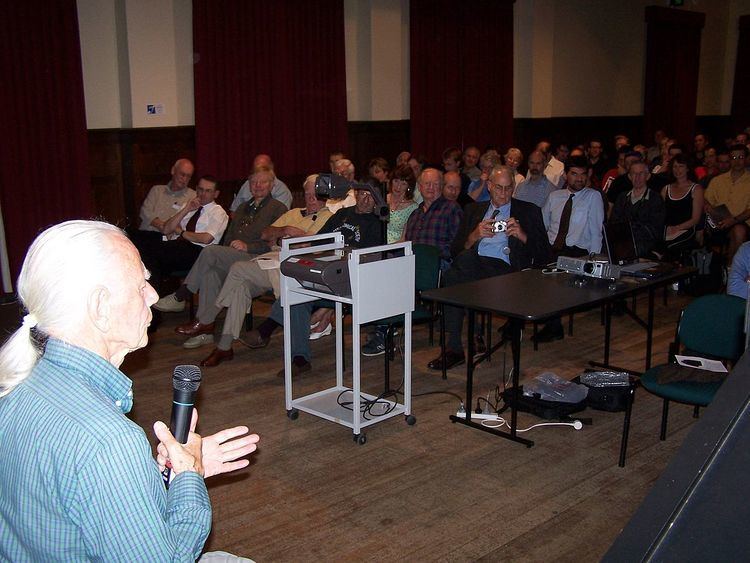Abbreviation ASV Region Victoria, Australia | Formation 1922 (1922) | |
 | ||
Motto Sic itur ad astra"this way to the stars" Legal status non-profit Incorporated association Location GPO Box 1059,Melbourne Vic 3001 Australia | ||
The Astronomical Society of Victoria (ASV) is an amateur astronomy club in the state of Victoria, Australia. It was founded in 1922, making it one of the oldest such clubs in the country, and with some 1000 members it claims to be one of the largest amateur astronomy organisations in the southern hemisphere. Membership is open to all with an interest in astronomy, and the society caters for people with a wide range of ages, backgrounds, abilities and interests.
Contents
- Structure and Purpose
- Meetings
- Observing sessions
- Great Melbourne Telescope Restoration Project
- Facilities
- Publications
- References
The society has sections dedicated to providing support for members interested in specific aspects of astronomy, including astro-photography, comets, radio astronomy, solar observing, variable stars, and deep sky observing. It owns a suburban property which is used as the Lodge and Observatory / workshop, and it also runs the Leon Mow (/ˈliːɒnmaʊ/)[ Dark Sky Site, located north of Melbourne. Its major project is the restoration of the Great Melbourne Telescope.
Structure and Purpose
The ASV is registered under the Associations Incorporation Reform Act 2012, and its operations are governed by its Constitution. Members elect the officers of the society and the Council at each Annual General Meeting, and that Council is then responsible to control and manage the business and affairs of the society.
The Society's purposes are stated in its constitution as follows:
- To educate the public in the science of astronomy, disseminate astronomical knowledge, and encourage the observation of the Universe.
- To bring into closer association persons engaged in astronomy in order to co-ordinate and assist their activities.
- To provide facilities to support members of the society in the practice and study of astronomy, including astronomical research.
- To collaborate actively with other institutions and groups, to the benefit of the society's activities and of astronomy in Victoria.
- To pursue any arrangements and activities conducive to the above purposes.
Meetings
Observing sessions
The society hosts several different types of observing sessions, aimed at different audiences, including:
Great Melbourne Telescope Restoration Project
For over 50 years the ASV has conducted tours and played a major role in the care of the Melbourne Observatory, in the Royal Botanic Gardens. This has now been supplemented with the Great Melbourne Telescope (GMT) Restoration Project, working closely with Museum Victoria and Royal Botanic Gardens to restore the telescope to working order so that it may be used for education and public viewing.
The telescope itself has great historical significance; at 48 inches (120 cm) it was the largest fully steerable telescope in the world when it was built in 1869, and it was the first telescope that large to be placed on an equatorial mounting, enabling it to track the stars accurately as they appeared to move across the sky. It was "hailed as a masterpiece of engineering", requiring only one assistant to control its movement. Even the rival Sydney Observatory referred to it as "one of the most important artefacts in the history of Australian science."
The telescope was upgraded by adding photographic equipment in 1872, moved to Mount Stromlo Observatory near Canberra in 1946, and rebuilt with a modern mirror in the late 1950s. As recently as 1993, it was upgraded again to take part in the world's first observations of MACHOs. It was badly damaged in the 2003 Canberra bushfires - the temperatures were so high that the aluminium dome itself caught fire and melted onto the telescope, the Pyrex mirror shattered, and steel struts sagged.
In mid 2009 a group of volunteers from the ASV began "Project Phoenix" to restore the telescope. The restoration project has required a worldwide scavenger hunt to find suitable parts. The project will incorporate bringing the telescope's optical, mechanical and electrical systems into line with current best practice.
After nearly five years weighing up different proposals, engineering work commenced in late 2013 thanks to a $70,000 grant from the Copland Foundation. Computer models were developed to design the supporting frame under a variety of extraordinary load conditions including wind and earthquake. The telescope-bearing frame was constructed and set up in the workshops in November 2013.
Facilities
The society provides the following facilities for members:
